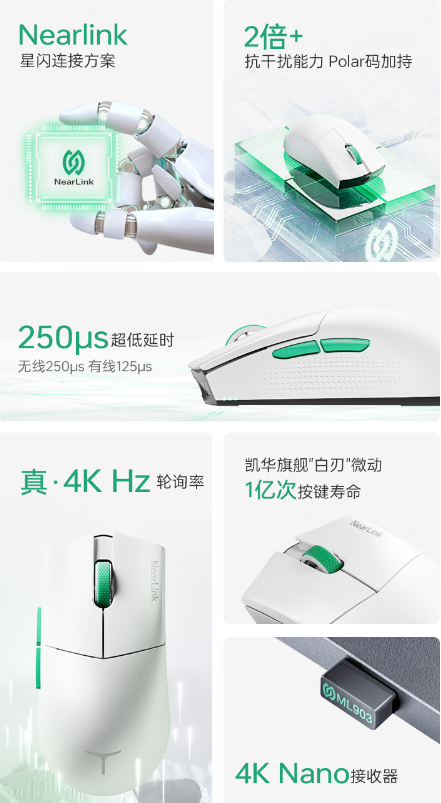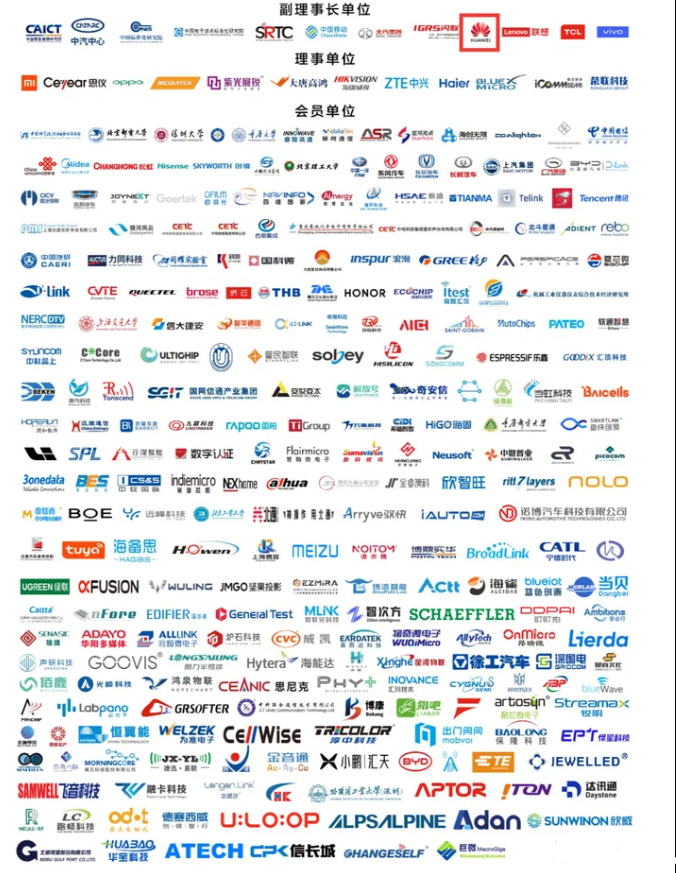Huawei StarLight, wants to revolutionize Bluetooth?
At a press conference some time ago, Huawei officially released a new generation of wireless connection technology - NearLink. Different from previous wireless technologies, NearLink is not developed based on the specifications of traditional wireless technologies such as Bluetooth. A new wireless connection specification created with years of accumulation of wireless technology.
If you didn’t watch the press conference, it doesn’t matter. Let’s take a quick look at StarLight: It uses a set of standards to combine the advantages of traditional wireless technologies such as Bluetooth and WIFI. This technology is suitable for consumer electronics, smart homes, New energy vehicles, industrial intelligent manufacturing and other scenarios. Compared with Bluetooth technology, the power consumption is reduced by 60%, the transmission rate is increased by 6 times, it has lower latency, more stable connection and anti-interference ability, the coverage distance is increased by 2 times, and the number of connections is increased by 10 times.
The above is the official explanation. From a technical point of view, the upper limit of each parameter of Star Flash is much higher than the current mainstream Bluetooth 5.3 protocol. Moreover, StarLight technology itself is compatible with a variety of wireless connection protocols, and the use of enhanced devices such as receivers can further improve latency and stability.
The wireless revolution has arrived
In recent years, wireless technology has become the main development direction of peripherals. From mice to keyboards, from headphones to speakers, wireless has become the main selling point of many new products. People are looking for ways to get rid of the shackles of cables and make their experience more free.
The surge in demand for wireless peripherals has also allowed the development of wireless technology to move forward rapidly. The miniaturization, low power consumption and high speed of wireless protocols such as Bluetooth to 2.4G are allowing us to get Better wireless connection experience. Take Qualcomm as an example. Its Snapdragon processor supports the proprietary Bluetooth transmission protocol, which can transmit data at a higher rate and stability, and easily complete the transmission of lossless music on wireless devices such as headphones.
In addition, audio manufacturers such as Sony are also developing their own wireless protocols. Protocols such as LHDC and LDAC have been popular in recent years. However, these protocols are all developed based on the Bluetooth specification, but use different coding logic to further increase the transmission bandwidth.
Star Flash is different. It provides the bottom layer of two connection technologies, SLE and SLB, and uses a new Polar code for protocol compilation. This new encoding system is far more efficient than the encoding system used by Bluetooth. , achieving transmission performance infinitely close to the channel limit.

Photo source: Star Flash
The technical indicators of Star Flash are also very exaggerated, with a delay of less than 20 microseconds. (The current mainstream wireless technology delay is generally at least 1 millisecond, which is 50 times that of Star Flash), multi-point synchronization accuracy is less than 1 microsecond, reliability is greater than 99.999% (under 20dB random burst interference), single-stream peak spectral efficiency Greater than 5bps/Hz.
Behind the amazing technical indicators, the core is the complete reconstruction of wireless technology. Compared with traditional Bluetooth technology, Star Flash is more like a variant of 5G technology. It has many 5G characteristics, but It has been greatly simplified, and you can think of it as a specialized 5G technology that also incorporates some Wi-Fi technology into it.
Compared with all current mainstream wireless protocols, even the latest Apple enhanced Bluetooth patent is lower than Star Flash in terms of bandwidth, latency, etc. Moreover, based on two different wireless bottom layers, Star Flash’s bandwidth The lower limit is extremely large and can reach 100kbps~12Mbps. For comparison, Apple's is 1Mbps~8Mbps. The flexible channel design allows StarLight to run at very low power according to the needs of the device, improving the battery life or reducing the size of small wireless devices.
It can be said that StarLight has all our current requirements for wireless technology, such as low power consumption, low latency, high bandwidth, etc. In my opinion, StarLand ecosystem has the opportunity to become the Chinese version of 3GPP or The IEEE Alliance allows us to gain more say in the understanding of wireless communications.
What is the current market performance of Star Flash Technology?
The commercial prospects of Star Flash
In a short period of time after the release of Star Flash, three peripherals equipped with Star Flash technology have been launched in China, namely Thor, VGN and Da Mosha is an emerging force in the field of peripherals. Its products are mainly aimed at professional gamers and have extremely high requirements for performance.
In their promotional page, we can also more intuitively see the current performance of StarLight technology on actual products. Taking Raytheon's products as an example, the technical parameters given are more than 2 times Anti-interference capability, the wireless mode delay is as low as 250 microseconds, and the wired mode is as low as 125 microseconds. The wireless mode supports a 4K Hz polling rate, and the wired mode supports an 8K Hz polling rate.

Source: JD
What are the concepts of these parameters? To put it simply, it is equivalent to directly making the product performance indicators of these emerging peripheral brands equal to the top products of the world's first-class peripheral manufacturers. Among the current mainstream peripheral brands, Razer has made the fastest progress in wireless technology. The new generation Viper v3 professional version also supports up to 4K Hz wireless mode and does not support 8K Hz wired mode. Moreover, the 4K Hz mode needs to be separated separately. Purchase an independent adapter base. As a comparison, mice from brands such as Thor that use StarLight technology only require a Nano receiver.
A higher polling rate can make the positioning of the mouse more detailed and accurate during operation, maximizing player skills. Mouse with high polling rate has always been the favorite of professional players. Before this, top peripherals have always been reserved for big international brands such as Logitech, but after the release of StarLight, this market may undergo some changes.
The attempt in the mouse market is just the beginning. The advantages of Starlight technology in the audio and video field are actually more significant. Compared with peripherals such as mice and keyboards, headphones need to transmit far more data in one second than ordinary ones. Peripherals, so the advantages of high bandwidth will be more obvious. Even mini wireless headsets such as TWS headsets, using StarLight technology, can achieve a real-time 1.5Mbps transmission rate without additional adapters and have extremely low latency.

Photo source: Huawei
As the quality of music streaming media becomes higher and higher (QQ Music, etc. have (can provide mastering-level sound quality), which also puts forward higher requirements for the transmission bandwidth of headphones. Only high-bandwidth wireless protocols can meet the transmission of high-quality music and bring users a better music experience.
Moreover, using StarLight technology, you can easily build an ultra-low-latency wireless sound system, solving the current problems of difficulty in building mid-to-low-end wireless home theaters, weak anti-interference ability, and high latency. If it is just the upgrade of the audio system, the revolution brought by it is secondary. The biggest change is actually in the field of wireless screen projection.
The current wireless screen projection technology, except for a few point-to-point millimeter wave screen projections, most other types of screen projection have obvious delays and poor anti-interference capabilities. Starlight technology uses With the advantage of high transmission rate, remote screen projection with 4K resolution can be easily completed, and the anti-interference performance is significantly better than traditional WiFi screen projection.
To some extent, the technical specifications of Star Flash are very close to the next generation Bluetooth 7.0 being developed by the Bluetooth Alliance. However, Star Flash is now commercially available, while Bluetooth 6.0 is still not available. Stay in beta. More than 100 domestic companies have joined the StarLight Alliance. As a global electronics manufacturing center, Chinese companies have a large say in the electronic digital field and will become the main force in promoting StarLight in the future.

Photo source: Star Flash
The above is the detailed content of Huawei StarLight, wants to revolutionize Bluetooth?. For more information, please follow other related articles on the PHP Chinese website!

Hot AI Tools

Undresser.AI Undress
AI-powered app for creating realistic nude photos

AI Clothes Remover
Online AI tool for removing clothes from photos.

Undress AI Tool
Undress images for free

Clothoff.io
AI clothes remover

Video Face Swap
Swap faces in any video effortlessly with our completely free AI face swap tool!

Hot Article

Hot Tools

Notepad++7.3.1
Easy-to-use and free code editor

SublimeText3 Chinese version
Chinese version, very easy to use

Zend Studio 13.0.1
Powerful PHP integrated development environment

Dreamweaver CS6
Visual web development tools

SublimeText3 Mac version
God-level code editing software (SublimeText3)

Hot Topics
 1386
1386
 52
52
 Leica Sofort 2: Strong Leica taste, but the image quality is not satisfactory
Jan 03, 2024 pm 04:08 PM
Leica Sofort 2: Strong Leica taste, but the image quality is not satisfactory
Jan 03, 2024 pm 04:08 PM
Yes, I spent more than 3,000 yuan to buy a real Leica camera. This is not a joint brand between Xiaomi and Sharp. It is a real Leica camera. It can even be found in the official Leica APP. It is a brand new product launched by Leica just last month - Sofort2. (Picture source: Photographed by Lei Technology) Last month I wrote an article commenting on Leica’s new machine, which is simply cutting leeks. The price of more than 3,000 yuan to buy such a machine is extremely high in the polaroid market. A backward product must have too much money and no place to spend it, and is simply a "big mistake". But adhering to the concept that if I don’t go to hell, who else will, I still placed an order for the Leica Sofort2 on the night it went on sale and became a “real” Leica user. Appearance: An exquisite toy? Leica Sofo
 OPPO did the right thing by giving up ProXDR
Jan 06, 2024 pm 11:37 PM
OPPO did the right thing by giving up ProXDR
Jan 06, 2024 pm 11:37 PM
Not long ago, OPPO announced at the Paris Film Festival that it was working with Kazakhstan and the Soviet Union to create a new generation of super light and shadow imaging systems, which will be launched on the OPPO Find X7 series. Choosing to announce this news at the world's largest and most influential photography exhibition shows how much OPPO attaches importance to the new generation of ultra-light and shadow imaging systems. According to OPPO, the new generation of Super Light and Shadow imaging system mainly consists of three parts: - Super Light and Shadow full main camera system, from increasing the zoom magnification to creating multi-view creative freedom; - Super Light and Shadow image engine, using more calculations to achieve less Computational traces; - Ultra-light and shadow ProXDR display, a photo display technology that conforms to the screen viewing method. Among them, "super light and shadow full main camera system" refers to the hardware of the imaging system, and "super light and shadow image engine" refers to the image
 Can Meizu 21 Pro compete head-to-head with flagships from major manufacturers?
Jan 03, 2024 pm 06:10 PM
Can Meizu 21 Pro compete head-to-head with flagships from major manufacturers?
Jan 03, 2024 pm 06:10 PM
On the last day of November, Meizu took advantage of the new wave of Snapdragon 8Gen3 phones to bring its annual flagship new phone, Meizu 21. Not long ago, this site also conducted a review of this product. It is a mobile phone with obvious advantages and disadvantages. Moreover, Meizu 21 currently only has one model, unlike other brands that are divided into medium and large sizes. For those who want a super flagship, Meizu 21 seems a bit not “Pro” enough. (Photo source: Photographed by this site) However, recent news about Meizu 21Pro has appeared on the Internet, which is good news for Meizu friends who want more extreme configuration and experience. The screen of Meizu 21 is not strong enough? 2K screen is coming! The charging power of Meizu 21 is not high enough, 100W fast charging is coming! Could it be that Meizu 21 is just a “small test”?
 Redefining human-computer interaction, Honor MagicOS 8.0 is officially released!
Jan 11, 2024 pm 10:06 PM
Redefining human-computer interaction, Honor MagicOS 8.0 is officially released!
Jan 11, 2024 pm 10:06 PM
On January 10, 2024, Honor held its first offline conference of the year in Shanghai, where MagicOS 8.0 officially debuted. MagicOS8.0 is a new self-developed operating system created by Honor. It is the industry's first new generation of human-computer interaction - intent-recognized human-computer interaction. In addition, the new system also brings many new functions based on AI, such as "Any Door", "Conversation into Movies", "Multi-modal Schedule Management", etc. (Photographed by Lei Technology) Honor calls MagicOS8.0 a new generation of interactive mode system after command line interaction, graphical interaction and natural interaction. As for how awesome it is, let’s take a look below. A system that can learn, a system that understands you better. When it comes to "AI", in fact, Honor created its first smartphone as early as 2016.
 Razer Viper V3 Pro review: What's the trade-off between power and portability?
Jan 03, 2024 pm 04:17 PM
Razer Viper V3 Pro review: What's the trade-off between power and portability?
Jan 03, 2024 pm 04:17 PM
In the discussion about gaming mice some time ago, Xiao Lei mentioned that the first true “gaming mouse” was the Razer Boomslang released by Razer in 2003 – a USB game with a DPI of “up to” 2500 and a polling rate of 125Hz. mouse. But in fact, the statement is not accurate, because this 2100/25 polling rate 00DPI Boomslang is actually an upgraded version of this series. Its previous generation, Boomslang released in 1999, is the real first game. mouse. Compared with the second generation released 4 years later, the first generation Boomslang used a more primitive PS/2 interface, and the polling rate was only 10-200Hz; until 2005
 New affordable Meta Quest 3S VR headset appears on FCC, suggesting imminent launch
Sep 04, 2024 am 06:51 AM
New affordable Meta Quest 3S VR headset appears on FCC, suggesting imminent launch
Sep 04, 2024 am 06:51 AM
The Meta Connect 2024event is set for September 25 to 26, and in this event, the company is expected to unveil a new affordable virtual reality headset. Rumored to be the Meta Quest 3S, the VR headset has seemingly appeared on FCC listing. This sugge
 Redmi Note 12 Turbo: Use tricks to create a flagship experience
Jan 15, 2024 pm 11:03 PM
Redmi Note 12 Turbo: Use tricks to create a flagship experience
Jan 15, 2024 pm 11:03 PM
In the TOP10 list of mobile phones with the largest shipments in 2022 announced by the market research organization Canalys, a mobile phone of the domestic brand Redmi appeared. Redmi Note 11 has also become the only domestic mobile phone on the list. When it comes to Redmi, every product is highly praised. It not only puts a lot of effort into materials and performance, but also provides a high-end flagship experience at a preferential price. What we are going to talk about today is Redmi’s latest Redmi Note12 Turbo, which uses magic to create a flagship experience. Appearance: In addition to releasing three standard colors of carbon fiber black, star sea blue, and ice feather white, Redmi Note12 Turbo also cooperated with "Harry Potter" to jointly create Note12 Turbo
 Huawei StarLight, wants to revolutionize Bluetooth?
Jan 11, 2024 pm 09:51 PM
Huawei StarLight, wants to revolutionize Bluetooth?
Jan 11, 2024 pm 09:51 PM
At a press conference some time ago, Huawei officially released a new generation of wireless connection technology - NearLink. Different from previous wireless technologies, NearLink is not developed based on the specifications of traditional wireless technologies such as Bluetooth, but Huawei's years of wireless experience. With the accumulation of technology, a new wireless connection specification is created. If you didn’t watch the press conference, it doesn’t matter. Let’s take a quick look at StarLight: it uses a set of standards to combine the advantages of traditional wireless technologies such as Bluetooth and WIFI. This technology is suitable for consumer electronics, smart homes, new energy vehicles, and industrial intelligence. Various scenes such as construction. Compared with Bluetooth technology, the power consumption is reduced by 60%, the transmission rate is increased by 6 times, it has lower latency, more stable connection and anti-interference ability, the coverage distance is increased by 2 times, and the number of connections is increased by 10 times. above




